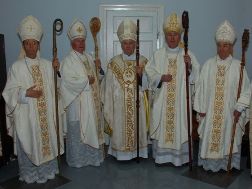HISTORY OF MARIAVITISM
The Mariavite Church is a Polish catholic confession created at the turn of the 19 and the 20 centuries as a result of a revelation received in 1893 by Roman Catholic nun Feliksa Kozłowska (1862-1921). The name “mariavite” is derived from latin “Mariae vita (imitans) which means “following the life of Mary”. It encourages the faithful to live in humility and accordance with the will of God while observing love to one’s neighbours. According to the revelation, Christ pointed out to the perpetual adoration of the Most Blessed Sacrament and the invocation for Our Lady's help as the act of God's Grace for the moral renewal of the worshippers and the clergy. The priests that followed that revelation created the Congregation of Mariavite Priests.
Mariavite priests, the majority of whom belonged to the elite of contemporary Polish clergy, engaged in active pastoral work in their parishes. However, their attempts to achieve the recognition of their congregation by the Roman Catholic Church both domestically and at the Holy See were in vain.
 In 1904 the Supreme Sacred Congregation of the Holy Office (currently the Congregation for the Doctrine of the Faith) ordered to dissolve the congregation. In 1906 Pius X supported that decision and personally excommunicated Feliksa Kozłowska and father Jan Kowalski on the grounds of their ecclesiastical disobedience. As a result, the mariavites founded an autonomic Church, independent of the Holy See. In 1909-1910 three mariavite priests received bishopric ordination from the bishops of the Old-catholic Church in the Netherlands and the Mariavite Church became member of the so called Union of Utrecht of old-catholic churches (the membership was suspended in 1924).
In 1904 the Supreme Sacred Congregation of the Holy Office (currently the Congregation for the Doctrine of the Faith) ordered to dissolve the congregation. In 1906 Pius X supported that decision and personally excommunicated Feliksa Kozłowska and father Jan Kowalski on the grounds of their ecclesiastical disobedience. As a result, the mariavites founded an autonomic Church, independent of the Holy See. In 1909-1910 three mariavite priests received bishopric ordination from the bishops of the Old-catholic Church in the Netherlands and the Mariavite Church became member of the so called Union of Utrecht of old-catholic churches (the membership was suspended in 1924).
Since their confessional separation, mariavite priests were conducting educational and charity work in their parishes. They created schools, kindergartens, libraries, craftsmen's workshops, homes for the aged and organizations supporting the poor.
Innovations introduced by archbishop Jan Kowalski after the death of the Foundress, Feliksa Kozłowska (1921), especially the abolition of celibate and ordaining women to the priesthood resulted in the split of the movement into two churches: the Old Catholic Mariavite Church and the Catholic Mariavite Church.

The Old Catholic Mariavite Church, with its headquarters in Płock has approx. 30,000 believers in 3 dioceses in Poland (mainly in Mazowieckie and Łódzkie voivodships) and the French Province. The clergy are educated at the Christian Theological Academy. The teaching of the Old Catholic Mariavite Church are based on the Bible, the dogmas instituted before the split of Christianity in 1054, the tradition of the universal Church defined at the first seven ecumenical councils and the revelations of Feliksa Kozłowska.
The Old Catholic Mariavite Church is a member of the Polish Ecumenical Council, the Conference of European Churches and the World Council of Churches. From 1997-2011 the church conducted ecumenical dialogue with the Roman Catholic Church. In 2000 the Roman Catholic Church, the Old Catholic Mariavite Church, and five other member churches of the Polish Ecumenical Council signed a common declaration on mutual recognition of the sacrament of baptism. The church has been also involved in the dialogue with the Union of Utrecht for a few years.
The Catholic Mariavite Church has its seat in Felicjanów near Płock. Archbishop Kowalski, the leader of the church, lost his life in Dachau, in the German concentration camp during the second world war. The Church has presently ca. 2,000 members. The clergy is mostly female and the church is led by female bishop, sister Beatrycze Szulgowicz.
The legal status of both churches is regulated by two acts passed by the Polish parliament in 1997. Many researchers stress the pioneering role of mariavites in the introduction of the vernacular to the liturgy (at the beginning of 20 century), frequent reception of the Holy Communion as well as other changes that were introduced by the Roman Catholic Church only after the Second Vatican Council.
Stanisław Rybak
References:
- K. Mazur „Mariawityzm w Polsce”, Kraków 1991 r.
- A. J. Papierowski „Geneza mariawityzmu jako ruchu religijnego i społecznego” [w] "Notatki Płockie", Towarzystwo Naukowe Płockie 1997 r., nr 2 i 3.
- S. Rybak „Mariawityzm. Studium historyczne”, Warszawa 1992 r.
